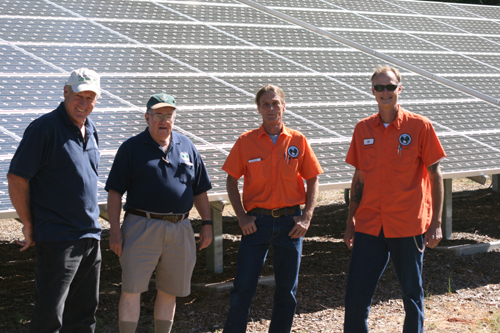

Although the solar facility was dedicated in May 2006, the solar panels have been collecting and converting the sun’s rays into earthly electricity since August 2005.
In these six years, IWD has generated more than 400,000 kilowatt-hours of electricity. That is enough energy to power an average 40 households in a year. Southern California Edison compares it to the energy for nearly 8,000 homes in a day or the energy to brew more than 14.7 million cups of coffee.
Even as this story is being written, the facility is generating more than 24 kilowatts. It operates year-round, producing power to run pumps for six wells, the water treatment plant and the inter-tie booster — all located at Foster Lake.
“It’s efficient, it saves some money and it’s good for the community,” says Allan Morphett, IWD president.
“The solar system provides us a hedge against escalating utility energy costs,” said Terry Lyons, IWD general manager. Other benefits of the system include the avoidance of additional greenhouse gases. IWD’s solar plant has produced electricity, which, if generated from coal or natural gas, would have produced nearly 500,000 pounds of carbon dioxide.
The plant’s construction costs were $310,000, which IWD and Southern California Edison (SCE) shared. Through July, IWD has saved more than $45,000. In addition, recent state legislation (A.B. 920) authorizes Edison to pay solar generators, such as IWD, for producing excess electricity, which is fed into Edison’s grid.
“You can see the arrows on the meters point backwards when we are supplying them,” said Ed Copelin, IWD’s Water Department chief operator. Edison installed the bidirectional meter to track the net difference between the amount of electricity a customer produces and the amount consumed.
According to Lyons and Directors Jim Billman and Warren Monroe, IWD could expand its solar capacity at Foster Lake. “We could double our size,” Monroe said.
This would provide power for other Foster Lake systems such as the aeration treatment plant, the two fuel tanks, the maintenance shop and other Foster Lake wells, according to Lyons.
“Especially in the winter months where we use less power, sizing a larger system would provide more surplus power to sell to SCE,” Lyons said.
“We’re very happy with the performance now. This is near perfect,” Lyons said. But to get to this point, IWD and its consultant manufacturer had to spend much time adjusting its equipment in order to assure that an Edison power failure would not shut down the Foster Lake facilities.
“At the time, it was new technology and in the research lab,” Monroe said.
“This system is one-of-a kind. If there is a power blackout our stand-alone system can continue to operate [IWD’s] facilities ...,” Lyons said. “Other solar systems are not stand-alone systems and can’t provide the needed thrust power. The solar system provides us the assurance and the peace of mind knowing we will have continued power for the delivery of water supplies.”










